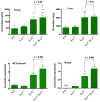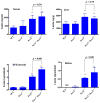Retinal accumulation of zeaxanthin, lutein, and β-carotene in mice deficient in carotenoid cleavage enzymes
- PMID: 28286282
- PMCID: PMC5494257
- DOI: 10.1016/j.exer.2017.02.016
Retinal accumulation of zeaxanthin, lutein, and β-carotene in mice deficient in carotenoid cleavage enzymes
Abstract
Carotenoid supplementation can prevent and reduce the risk of age-related macular degeneration (AMD) and other ocular disease, but until now, there has been no validated and well-characterized mouse model which can be employed to investigate the protective mechanism and relevant metabolism of retinal carotenoids. β-Carotene oxygenases 1 and 2 (BCO1 and BCO2) are the only two carotenoid cleavage enzymes found in animals. Mutations of the bco2 gene may cause accumulation of xanthophyll carotenoids in animal tissues, and BCO1 is involved in regulation of the intestinal absorption of carotenoids. To determine whether or not mice deficient in BCO1 and/or BCO2 can serve as a macular pigment mouse model, we investigated the retinal accumulation of carotenoids in these mice when fed with zeaxanthin, lutein, or β-carotene using an optimized carotenoid feeding method. HPLC analysis revealed that all three carotenoids were detected in sera, livers, retinal pigment epithelium (RPE)/choroids, and retinas of all of the mice, except that no carotenoid was detectable in the retinas of wild type (WT) mice. Significantly higher amounts of zeaxanthin and lutein accumulated in the retinas of BCO2 knockout (bco2-/-) mice and BCO1/BCO2 double knockout (bco1-/-/bco2-/-) mice relative to BCO1 knockout (bco1-/-) mice, while bco1-/- mice preferred to take up β-carotene. The levels of zeaxanthin and lutein were higher than β-carotene levels in the bco1-/-/bco2-/- retina, consistent with preferential uptake of xanthophyll carotenoids by retina. Oxidative metabolites were detected in mice fed with lutein or zeaxanthin but not in mice fed with β-carotene. These results indicate that bco2-/- and bco1-/-/bco2-/- mice could serve as reasonable non-primate models for macular pigment function in the vertebrate eye, while bco1-/- mice may be more useful for studies related to β-carotene.
Keywords: Carotenoid cleavage; Carotenoid metabolism; HPLC; Knockout mice; Retina.
Copyright © 2017 Elsevier Ltd. All rights reserved.
Figures




Similar articles
-
Lutein and zeaxanthin reduce A2E and iso-A2E levels and improve visual performance in Abca4-/-/Bco2-/- double knockout mice.Exp Eye Res. 2021 Aug;209:108680. doi: 10.1016/j.exer.2021.108680. Epub 2021 Jun 20. Exp Eye Res. 2021. PMID: 34161819 Free PMC article.
-
HDL is the primary transporter for carotenoids from liver to retinal pigment epithelium in transgenic ApoA-I-/-/Bco2-/- mice.Arch Biochem Biophys. 2022 Feb 15;716:109111. doi: 10.1016/j.abb.2021.109111. Epub 2021 Dec 20. Arch Biochem Biophys. 2022. PMID: 34942193 Free PMC article.
-
Inactivity of human β,β-carotene-9',10'-dioxygenase (BCO2) underlies retinal accumulation of the human macular carotenoid pigment.Proc Natl Acad Sci U S A. 2014 Jul 15;111(28):10173-8. doi: 10.1073/pnas.1402526111. Epub 2014 Jun 30. Proc Natl Acad Sci U S A. 2014. PMID: 24982131 Free PMC article. Clinical Trial.
-
Enzymology of vertebrate carotenoid oxygenases.Biochim Biophys Acta Mol Cell Biol Lipids. 2020 Nov;1865(11):158653. doi: 10.1016/j.bbalip.2020.158653. Epub 2020 Feb 5. Biochim Biophys Acta Mol Cell Biol Lipids. 2020. PMID: 32035229 Free PMC article. Review.
-
Nutritional factors and visual function in premature infants.Proc Nutr Soc. 2001 May;60(2):171-8. doi: 10.1079/pns200089. Proc Nutr Soc. 2001. PMID: 11681632 Review.
Cited by
-
Prenatal Carotenoid Supplementation With Lutein or Zeaxanthin Ameliorates Oxygen-Induced Retinopathy (OIR) in Bco2-/- Macular Pigment Mice.Invest Ophthalmol Vis Sci. 2023 Apr 3;64(4):9. doi: 10.1167/iovs.64.4.9. Invest Ophthalmol Vis Sci. 2023. PMID: 37036416 Free PMC article.
-
Lycium barbarum L.: a potential botanical drug for preventing and treating retinal cell apoptosis.Front Pharmacol. 2025 Mar 20;16:1571554. doi: 10.3389/fphar.2025.1571554. eCollection 2025. Front Pharmacol. 2025. PMID: 40183099 Free PMC article. Review.
-
Carotenoids: Importance in Daily Life-Insight Gained from EPR and ENDOR.Appl Magn Reson. 2021;52(8):1093-1112. doi: 10.1007/s00723-021-01311-8. Epub 2021 Mar 20. Appl Magn Reson. 2021. PMID: 33776215 Free PMC article. Review.
-
The Role of Diet, Micronutrients and the Gut Microbiota in Age-Related Macular Degeneration: New Perspectives from the Gut⁻Retina Axis.Nutrients. 2018 Nov 5;10(11):1677. doi: 10.3390/nu10111677. Nutrients. 2018. PMID: 30400586 Free PMC article. Review.
-
Lutein and zeaxanthin reduce A2E and iso-A2E levels and improve visual performance in Abca4-/-/Bco2-/- double knockout mice.Exp Eye Res. 2021 Aug;209:108680. doi: 10.1016/j.exer.2021.108680. Epub 2021 Jun 20. Exp Eye Res. 2021. PMID: 34161819 Free PMC article.
References
-
- Age-Related Eye Disease Study 2 Research G. Chew EY, SanGiovanni JP, Ferris FL, Wong WT, Agron E, Clemons TE, Sperduto R, Danis R, Chandra SR, Blodi BA, Domalpally A, Elman MJ, Antoszyk AN, Ruby AJ, Orth D, Bressler SB, Fish GE, Hubbard GB, Klein ML, Friberg TR, Rosenfeld PJ, Toth CA, Bernstein P. Lutein/zeaxanthin for the treatment of age-related cataract: AREDS2 randomized trial report no. 4. JAMA Ophthalmology. 2013;131:843–850. - PMC - PubMed
Publication types
MeSH terms
Substances
Grants and funding
LinkOut - more resources
Full Text Sources
Other Literature Sources
Medical
Molecular Biology Databases

